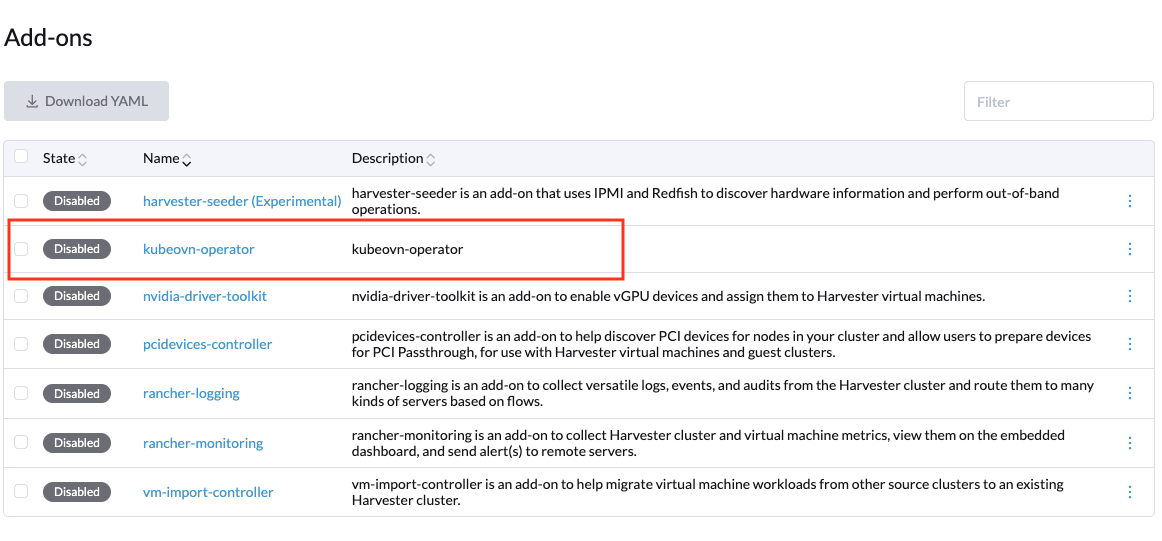Kube-OVN Operator (Experimental)
Available as of v1.6.0
kubeovn-operator is an experimental add-on. For more information about experimental features, see Feature Labels.
kubeovn-operator is used to manage the lifecycle of Kube-OVN as a secondary CNI on underlying Harvester clusters.
Enabling kubeovn-operator
You must enable kubeovn-operator to deploy Kube-OVN to a Harvester cluster for advanced SDN capabilities such as virtual private cloud (VPC) and subnets for virtual machine workloads.
On the Harvester UI, go to Advanced > Add-ons.
Select kubeovn-operator (Experimental), and then select ⋮ > Enable.

The add-on deploys kubeovn-operator and creates the default Configuration object named configuration.kubeovn.io, which uses sane Harvester-specific defaults for configuring the Kube-OVN CNI.
The following is an example of a Configuration object:
apiVersion: kubeovn.io/v1
kind: Configuration
metadata:
name: kubeovn
namespace: kube-system
spec:
cniConf:
cniBinDir: /opt/cni/bin
cniConfFile: /kube-ovn/01-kube-ovn.conflist
cniConfigDir: /etc/cni/net.d
cniConfigPriority: "90"
localBinDir: /usr/local/bin
components:
OVSDBConTimeout: 10
OVSDBInactivityTimeout: 10
checkGateway: true
enableANP: false
enableBindLocalIP: true
enableExternalVPC: true
enableIC: false
enableKeepVMIP: true
enableLB: true
enableLBSVC: false
enableLiveMigrationOptimize: true
enableNATGateway: true
enableNP: true
enableOVNIPSec: false
enableTProxy: false
hardwareOffload: false
logicalGateway: false
lsCtSkipOstLportIPS: true
lsDnatModDlDst: true
secureServing: false
setVLANTxOff: false
u2oInterconnection: false
debug:
mirrorInterface: mirror0
dpdkCPU: "0"
dpdkMEMORY: "0"
dpdkVersion: "19.11"
dualStack:
joinCIDR: fd00:100:64::/112
pingerExternalAddress: 2606:4700:4700::1111
pingerExternalDomain: google.com.
podCIDR: fd00:10:16::/112
podGateway: fd00:10:16::1
serviceCIDR: fd00:10:96::/112
global:
images:
kubeovn:
dpdkRepository: kube-ovn-dpdk
repository: kube-ovn
supportArm: true
thirdParty: true
vpcRepository: vpc-nat-gateway
registry:
address: docker.io/kubeovn
hugePages: "0"
hugepageSizeType: hugepages-2Mi
imagePullPolicy: IfNotPresent
ipv4:
joinCIDR: 100.64.0.0/16
pingerExternalAddress: 1.1.1.1
pingerExternalDomain: google.com.
podCIDR: 10.54.0.0/16
podGateway: 10.54.0.1
serviceCIDR: 10.55.0.1
ipv6:
joinCIDR: fd00:100:64::/112
pingerExternalAddress: 2606:4700:4700::1111
pingerExternalDomain: google.com.
podCIDR: fd00:10:16::/112
podGateway: fd00:10:16::1
serviceCIDR: fd00:10:96::/112
kubeOvnCNI:
requests:
cpu: "100m"
memory: "100Mi"
limits:
cpu: "1"
memory: "1Gi"
kubeOvnController:
requests:
cpu: "200m"
memory: "200Mi"
limits:
cpu: "1"
memory: "1Gi"
kubeOvnMonitor:
requests:
cpu: "200m"
memory: "200Mi"
limits:
cpu: "200m"
memory: "200Mi"
kubeOvnPinger:
requests:
cpu: "100m"
memory: "100Mi"
limits:
cpu: "200m"
memory: "400Mi"
kubeletConfig:
kubeletDir: /var/lib/kubelet
logConfig:
logDir: /var/log
masterNodesLabel: node-role.kubernetes.io/control-plane=true
networking:
defaultSubnet: ovn-default
defaultVPC: ovn-cluster
enableECMP: false
enableEIPSNAT: true
enableMetrics: true
enableSSL: false
netStack: ipv4
networkType: geneve
nodeSubnet: join
ovnLeaderProbeInterval: 5
ovnNorthdNThreads: 1
ovnNorthdProbeInterval: 5000
ovnRemoteOpenflowInterval: 10
ovnRemoteProbeInterval: 10000
podNicType: veth-pair
probeInterval: 180000
tunnelType: vxlan
nodeLocalDNSIPS: ""
vlan:
providerName: provider
vlanId: 1
vlanName: ovn-vlan
openVSwitchDir: /var/lib/rancher/origin/openvswitch
ovnCentral:
requests:
cpu: 300m
memory: 200Mi
limits:
cpu: 3
memory: 4Gi
ovnDir: /etc/origin/ovn
ovsOVN:
limits:
cpu: 2
memory: 1000Mi
requests:
cpu: 200m
memory: 200Mi
performance:
gcInterval: 360
inspectInterval: 20
ovsVSCtlConcurrency: 100
Ensure that the Kube-OVN IPv4 pod and service CIDR blocks do not overlap with the Harvester pod and service CIDR blocks.
This Configuration object has been validated against Harvester installations. You can fine-tune the object by editing the kubeovn-operator add-on YAML, but exercise caution when making changes to the configurationSpec field.
Disabling kubeovn-operator
Ensure that no virtual machines are using VM Networks backed by Kube-OVN SDN components.
Disabling the kubeovn-operator is a disruptive process
You can disable kubeovn-operator using the following commands:
kubectl delete configuration kubeovn -n kube-system --wait=false
kubectl delete validatingwebhookconfiguration kube-ovn-webhook --ignore-not-found
kubectl delete ips --all
kubectl delete subnets join ovn-default --ignore-not-found
kubectl delete vpc ovn-cluster --ignore-not-found
# Remove annotations/labels in namespaces and nodes
kubectl annotate node --all ovn.kubernetes.io/cidr-
kubectl annotate node --all ovn.kubernetes.io/gateway-
kubectl annotate node --all ovn.kubernetes.io/ip_address-
kubectl annotate node --all ovn.kubernetes.io/logical_switch-
kubectl annotate node --all ovn.kubernetes.io/mac_address-
kubectl annotate node --all ovn.kubernetes.io/port_name-
kubectl annotate node --all ovn.kubernetes.io/allocated-
kubectl annotate node --all ovn.kubernetes.io/chassis-
kubectl label node --all kube-ovn/role-
kubectl annotate ns --all ovn.kubernetes.io/cidr-
kubectl annotate ns --all ovn.kubernetes.io/exclude_ips-
kubectl annotate ns --all ovn.kubernetes.io/gateway-
kubectl annotate ns --all ovn.kubernetes.io/logical_switch-
kubectl annotate ns --all ovn.kubernetes.io/private-
kubectl annotate ns --all ovn.kubernetes.io/allow-
kubectl annotate ns --all ovn.kubernetes.io/allocated-
# Remove annotations in all pods of all namespaces
for ns in $(kubectl get ns -o name | awk -F/ '{print $2}'); do
echo "annotating pods in namespace $ns"
kubectl annotate pod --all -n $ns ovn.kubernetes.io/cidr-
kubectl annotate pod --all -n $ns ovn.kubernetes.io/gateway-
kubectl annotate pod --all -n $ns ovn.kubernetes.io/ip_address-
kubectl annotate pod --all -n $ns ovn.kubernetes.io/logical_switch-
kubectl annotate pod --all -n $ns ovn.kubernetes.io/mac_address-
kubectl annotate pod --all -n $ns ovn.kubernetes.io/port_name-
kubectl annotate pod --all -n $ns ovn.kubernetes.io/allocated-
kubectl annotate pod --all -n $ns ovn.kubernetes.io/routed-
kubectl annotate pod --all -n $ns ovn.kubernetes.io/vlan_id-
kubectl annotate pod --all -n $ns ovn.kubernetes.io/network_type-
kubectl annotate pod --all -n $ns ovn.kubernetes.io/provider_network-
done
You must reboot each node to complete the uninstallation process.
Once the nodes are rebooted, you can disable the kubeovn-operator add-on from the Harvester UI.